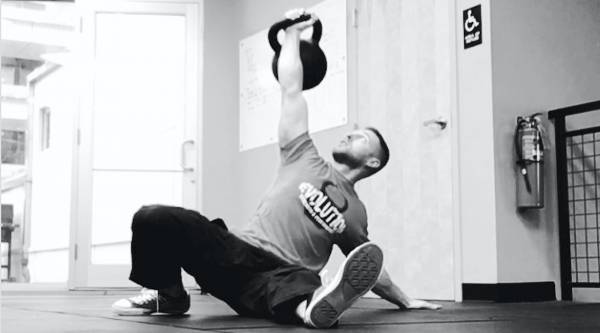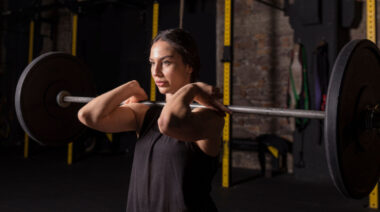I was 12 years old when I first stepped into a weight room. From that day forward, I wanted to get big, strong, and build bulky muscles. A big chest, big arms, and 6-pack abs – if you had those qualities, that meant you were strong.
I was 12 years old when I first stepped into a weight room. From that day forward, I wanted to get big, strong, and build bulky muscles. A big chest, big arms, and 6-pack abs – if you had those qualities, that meant you were strong.
If only it was that simple. I’ve met many people who don’t bench press and don’t have 6-pack abs yet would smoke you in any strength-related feat and probably can run faster than you. Inversely I’ve met many men who have big arms, a big chest, and a 6-pack yet can’t swing a 53lb kettlebell. So what gives?
As a StrongFirst Instructor, kettlebells have given me the most all-around body strength I’ve ever had. Additionally, I’ve found myself setting new PR’s in lifts I haven’t even trained for in months. For example, I hit a 40kg pistol squat a month ago after not training pistols in several months. More on that in a minute.
Training with kettlebells has shown me that there are five qualities everyone needs in order to be considered “strong,” and there are two exercises that will give you all five qualities. When done consistently, you’ll find yourself stumbling on life-changing strength in a matter of months. If only I could go back and tell my twelve-year-old self.
Learn to master the swing and the get-up, and be patient. [Photo courtesy of Pixabay]
Quality 1: A Strong Core
Total body strength is really about creating tension from the ground up. Create maximum internal tension to fight the external load you’re working with and you will stand a much better chance at hitting a successful lift. If you can’t generate appreciable tension here, you stand little chance at being seriously strong.
Quality 2: A Strong Grip
Grip strength can tell you a lot about someone. Having appreciable grip strength is absolutely necessary. If you can’t hold a weight, how are you supposed to lift it? Try this:
- Make a light fist. Where do you feel most of the tension in your hand?
- Now squeeze a little harder, perhaps the tension has worked its way up to your forearm.
- Squeeze harder again. Now it’s creeping up your biceps and triceps.
- Squeeze harder yet. Now your delt and lat kick in.
- Squeeze even harder and you’ll feel your core tighten.
If you’re standing up, you can tap into your glutes and quads as well. Strength is a skill that can be taught, and often it starts in your hands.
Quality 3: Strong, Healthy Shoulders
Longevity is the name of the game if you want to get strong. You can’t expect to get very strong if you’re on a program that all but ensures you need rotator cuff surgery in 6-8 months. Most people I train have a hard time raising their arm over their head, let alone lifting any sort of appreciable weight.
A strong shoulder is one that can not only stabilize under significant load, but also one that functions well in a myriad of tasks such as hanging, crawling, hand balancing, reaching across, above, and behind your body. These are everyday tasks you should be able to perform.
Quality 4: Strong, Mobile Hips
I’ve never met someone I considered “strong’ who didn’t look like they had some meat on their legs. Likewise, these strong gents and ladies can move very well.
As the Olympics title them, “athletics” (the track and field athletes) are perhaps the best examples of what it means to have strong, mobile hips. Sprinting and jumping are two great examples of what having strong, mobile hips can do for you – from a performance and aesthetics standpoint.
Quality 5: Patience
This is the most important quality of all. If you want to be strong you need to have patience, and lots of it. Strength isn’t made overnight, or over a couple weeks. Lack of patience is one of the biggest reasons I see people fail to achieve their goals.
Developing appreciable strength takes time, and that’s just all there is to it. Treating your mind like a muscle, practicing mindfulness, and focusing on the here and now go a long way in developing serious, long-lasting strength.
Two Exercises To Crack the Strength Code
You’re doing too much.
Really, stop wasting your time and get on a sustainable, consistent program. Stop hopping from machine to machine, or toying around with fancy new fitness products hoping they will yield that life-changing look you’re seeking. Also see my above comments on patience.
Unless you’re an athlete (and even then I’d argue most athletes can do very well for themselves by mastering these two lifts) you really don’t need to be doing anything other than two exercises; kettlebell swings and get-ups.
That’s it. Two lifts, 4-6 days a week. Maintain consistent, sustainable training.
Let’s dive into why these two lifts rule the world and how you can start using them today.
Lift 1: 1-Arm Kettlebell Swing
Keeping in mind our list above, the 1-arm kettlebell swing gives you everything you need to get seriously strong.
A Strong Core
In the one arm swing, the bell is trying to twist you and fly away from you at the same time. Resisting that rotation while driving force into the floor is what will light up your core. Think “anti-rotation” core training (Pallof presses, suitcase carries) multiplied by the force of swinging a 106lb kettlebell.
A Strong Grip
The moment you start to swing a kettlebell the weight of the bell changes. It goes from literally becoming weightless at the top, while multiplying 2-3x at the bottom. Add force and velocity and you wind up needing a vice-like grip to hang onto a heavy bell.
Strong, Healthy Shoulders
When you swing heavy bells you need to hang on tight for the reasons mentioned above (anti-rotation, force, and velocity). Doing so while packing your shoulder will lead to a very strong shoulder girdle and upper back.
Strong, Mobile Hips
You can really consider the swing a dynamic deadlift. There is significant carryover into power lifts, and other lifts as well. Remember my mention of busting out a 40kg pistol squat after not training it in months? Three months of heavy swings and get-ups is what got me there. The “what the hell” effect is real, and swings and get-ups will give it to you.
Patience
Aside from having to be patient with your training program as a whole, the swing itself also requires patience.
The top of the swing is a hard, plank-like lockout. The lockout is reached by driving force into the floor, which travels back up through your body. When done properly, the bell will float momentarily – weightless – it’s during this time that you must practice patience and allow the bell to come back to you while at the same time mainlining your lockout.
Once your upper arms hit your rib cage you’ll quickly hinge back and fire up for another rep. Rushing the swing will lead to poor mechanics and possible injury. Proper execution leads to strong, quick, and powerful hips that will help you live a healthy life and/or perform better in your sport.
Lift 2: The Get-up
The get-up will most definitely help you develop a strong core, shoulders, and hips. Gray Cook considers the get-up “loaded yoga,” and it really is just that. From rolling, to crawling, to kneeling, to standing, and back down again, the get-up is the one exercise that gives you everything you need from a movement perspective. Throw some heavy weight on top of that and you’re well on your way to building a bulletproof body.
Although I teach the get-up piece by piece, the finished product is one fluid, smooth, controlled movement. Throughout that movement you have two constants:
- Core activation
- Controlled, quality movement
Time under tension is a huge reason why the get-up builds strong shoulders and leads to mobile hips. One rep should take you roughly 30-45 seconds to complete, which makes it comparable in time under tension to a set of eight bench presses performed with a full second pause at the top and bottom of each rep. Perform ten total reps of the get-up and you’re looking at 80 total reps of the bench press.
Throw in the broad spectrum of movements you go through in one rep (t-spine rotation, hip flexion, hip extension, internal and external rotation of the hips and shoulders), and you’re getting a lot of quality work done in a very short amount of time.
If you want to stabilize that heavy bell over your head you’ll want to tap into those tension strategies I touched on earlier. Lightly grasping a heavy bell is no way to stabilize 100 pounds over your head. This voluntary trigger of tension will help develop a rock solid grip.
Simply put, the get-up should be a mindful practice. You need to focus on the weight above your head and move in a controlled manner around the bell. You could also just make sure you’re using a heavy bell, which demands your full and undivided attention. Breathe, relax, and focus on your set.

By using these two exercises, you’ll find yourself stumbling on life-changing strength in a matter of months. [Photo courtesy of Chris Abbott]
Bringing It All Together
I’ve just saved you a whole lot of time in helping you gain some serious strength. Remember, you’ve cracked the strength code once you have:
- A strong core
- A strong grip
- Strong, healthy shoulders
- Strong, mobile hips
- Patience
Learn to master the swing and get-up, and be patient. Less is more – way more!
More on kettlebell training:






